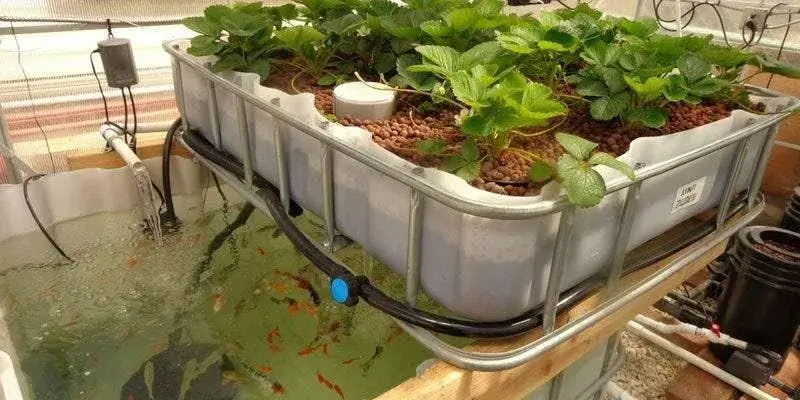- What is Aquaponic?
- Types of Aquaponic systems
- Advantages of Aquaponic system
- Disadvantages of Aquaponic system
- Conclusion
What is Aquaponic?
Aquaponic systems are an innovative and sustainable method of food production that combines aquaculture and hydroponics in a symbiotic system. The system works by cultivating plants and fish in a closed-loop system, where the waste produced by the fish is converted into nutrients for the plants, and the plants in turn clean and filter the water for the fish.
The basic components of an aquaponic system include a fish tank, where the fish are raised, and a hydroponic bed, where the plants are grown. The water from the fish tank is circulated through the hydroponic bed, providing the plants with nutrients, and the plants clean and filter the water, which is then returned to the fish tank.
Aquaponics is a sustainable and efficient method of food production, as it eliminates the need for soil, pesticides, and fertilizers. It also uses less water compared to traditional farming methods, as the water is recycled and reused in the system. Additionally, the fish and plants in an aquaponic system can be harvested for food, providing a source of fresh and healthy produce and protein.
Aquaponic systems are becoming increasingly popular for both commercial and home use, as they can be set up in a small space and require minimal maintenance. With the right setup and management, aquaponic systems can be highly productive and provide a sustainable source of fresh produce and fish.
Types of Aquaponic systems
Aquaponic systems come in different types, with each having unique features and benefits. Here are some of the most common types of aquaponic systems:
Media-based aquaponics
This is the most popular type of aquaponic system, in which plants grow in a media-filled grow bed, and the water is circulated through the bed to provide nutrients to the plants. The media serves as a biological filter, where beneficial bacteria break down fish waste into plant nutrients.
Nutrient film technique (NFT)
In this system, plants grow in shallow channels, and a thin film of nutrient-rich water flows through the channels. The roots of the plants absorb the nutrients they need, and the filtered water is returned to the fish tank.
Deep water culture (DWC)
This system involves suspending plants on rafts or net pots above the fish tank, and their roots are submerged in nutrient-rich water. The system requires a continuous flow of oxygenated water to ensure the plants get enough oxygen.
Vertical aquaponics
This system maximizes space by growing plants vertically in stacked layers or towers. The water is pumped from the fish tank to the top of the tower, and it flows down through the layers, providing nutrients to the plants.
Recirculating aquaponics
This system recirculates the water from the fish tank to the plant beds, and back to the fish tank. The system includes a mechanical filter that removes solids and a biofilter that removes dissolved wastes.
Integrated aquaponics
This system combines aquaponics with other systems such as hydroponics, greenhouse production, or even livestock production. The integration provides additional benefits such as energy efficiency and sustainable waste management.
Each type of aquaponic system has its pros and cons, and the choice depends on factors such as space availability, budget, and the types of plants and fish to be grown.
Advantages of Aquaponic system
Resource efficiency
Aquaponic systems are resource-efficient because they use less water, land, and energy than traditional farming methods. The water is recycled through the system, and the nutrients are constantly replenished.
High yield
Aquaponic systems have higher crop yields compared to traditional farming because the plants receive a constant supply of nutrients and water.
Reduced environmental impact
Aquaponic systems produce less waste and greenhouse gas emissions than traditional farming because the nutrients are recycled within the system.
Diverse crops
Aquaponic systems can grow a variety of crops, including vegetables, herbs, fruits, and ornamental plants, making them ideal for urban and peri-urban areas.
Organic produce
Aquaponic systems can produce organic produce without the use of pesticides, herbicides, or synthetic fertilizers.
Disadvantages of Aquaponic system
High initial costs:
Setting up an aquaponic system can be expensive due to the cost of equipment and materials.
Technical expertise:
Operating an aquaponic system requires technical knowledge and expertise, including knowledge of water chemistry, fish husbandry, and plant cultivation.
Risk of fish disease:
Fish in aquaponic systems are susceptible to disease, which can be costly to treat.
Electricity dependence:
Aquaponic systems require electricity to power pumps and other equipment, making them vulnerable to power outages.
Limited fish species:
Not all fish species are suitable for aquaponics, limiting the choice of fish to be grown in the system.
CONCLUSION
Aquaponic systems provide a sustainable and efficient way of farming that combines aquaculture and hydroponics. These systems offer several advantages such as high yield, reduced environmental impact, and diverse crop production. However, they also have some disadvantages such as high initial costs, technical expertise requirements, and limited fish species options.
Despite the challenges, aquaponics has gained popularity in recent years due to its potential to produce fresh and healthy produce, reduce water usage, and decrease the carbon footprint of farming. Aquaponics can be used in a variety of settings, including urban areas, and can provide fresh, organic, and nutrient-rich food. As technology advances and awareness grows, aquaponics will likely continue to evolve and play a more significant role in sustainable food production.

